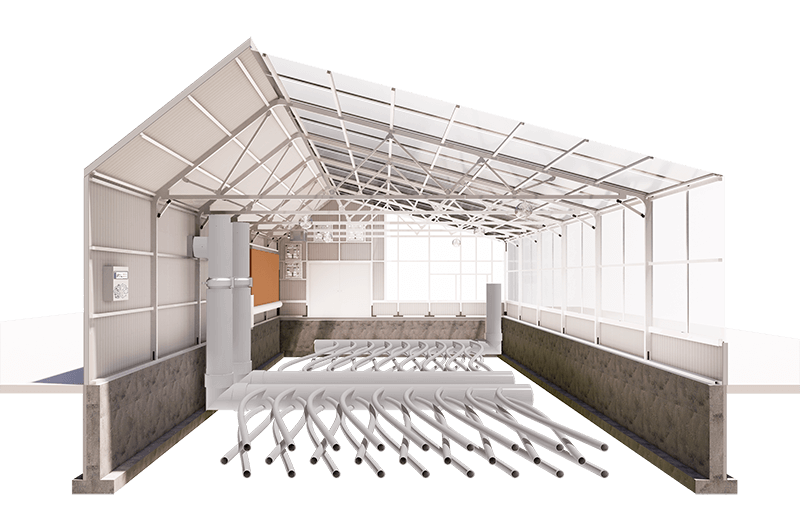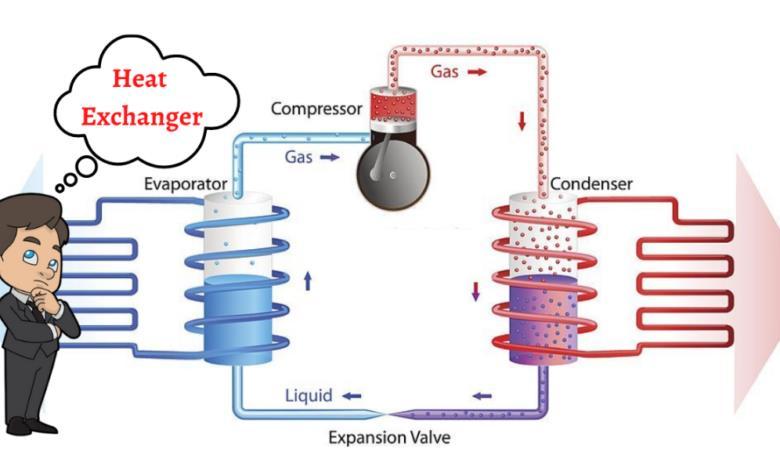Checking out the Benefits and Applications of Heat Transfer Systems in Modern Industry
Heat transfer systems play an essential role in modern-day sector. They include numerous devices such as radiation, transmission, and convection, each adding to reliable thermal management. Industries like production and aerospace advantage significantly from these systems. As improvements continue, the combination of ingenious products and innovations guarantees to enhance power effectiveness. This development elevates crucial inquiries about the future ramifications for sustainability and functional expenses across several markets. What exists ahead in this continuous transformation?
Understanding Heat Transfer Principles
Heat transfer principles are fundamental to the operation of numerous commercial systems. These concepts include the mechanisms of convection, radiation, and transmission, each playing a vital function in taking care of thermal energy. Recognizing conduction involves assessing how Heat moves via strong products, while convection relate to Heat transfer in liquids, driven by liquid motion. Radiation, distinct from the other two, involves power transfer with electromagnetic waves. The performance of Heat transfer influences system performance, power consumption, and general performance. Effective thermal administration is crucial in processes such as air conditioning, Heat, and home heating recovery. By grasping these principles, industries can enhance their operations, lower energy costs, and improve tools longevity, therefore contributing to a much more lasting and reliable commercial landscape.
Secret Sorts Of Heat Transfer Systems
While numerous sectors use Heat transfer systems for diverse applications, a number of key types stand out as a result of their details functions and efficiencies. One of the most common types include conduction, radiation, and convection systems. Transmission systems transfer Heat with direct contact between products, making them efficient in solid-state applications. Convection systems, on the various other hand, make use of liquid movement to move Heat, appropriate for heating or cooling down liquids and gases. Radiation systems operate without a medium, relying upon electromagnetic waves to move Heat, ideal for high-temperature settings. Each kind serves unique objectives, allowing markets to tailor their Heat transfer options based upon functional requirements, energy performance, and cost-effectiveness. Recognizing these systems is crucial for maximizing efficiency in different industrial setups.
Industrial Applications of Heat Transfer Technologies
The application of Heat transfer modern technologies in industry plays an essential function in improving energy effectiveness and optimizing processes. DVS Heat Transfer Systems. By implementing innovative Heat exchange systems, business can considerably decrease their ecological influence while improving general efficiency. This integration not just fosters sustainability but also straightens with modern-day regulative and customer demands for greener techniques
Power Performance Improvements
As sectors increasingly focus on sustainability, power effectiveness renovations in Heat transfer innovations have actually become necessary for minimizing operational prices and ecological impact. Improved Heat exchangers, for example, make use of sophisticated materials and styles to make the most of thermal performance while decreasing power consumption. Furthermore, incorporating variable speed drives in pumping systems permits for better control of fluid circulation, resulting in considerable power savings. The implementation of wise sensing units and automation gives real-time tracking, enabling changes that enhance energy usage. In addition, waste Heat healing systems record excess thermal energy, converting it into usable power. These improvements not just enhance power efficiency however also contribute to an extra lasting industrial landscape by lowering greenhouse gas exhausts and supporting compliance with ecological policies.
Refine Optimization Techniques
Refine optimization techniques are vital in improving the effectiveness and efficiency of Heat transfer technologies in industrial applications. These techniques entail refining procedures to take full advantage of Heat transfer performance while decreasing energy consumption and functional costs. Techniques such as computational liquid characteristics (CFD) modeling enable engineers to assess and replicate Heat transfer scenarios, identifying locations for improvement. Additionally, real-time monitoring systems can offer important information on temperature level gradients and circulation rates, making it possible for modifications that enhance performance. Additionally, carrying out advanced control approaches, such as predictive analytics, can enhance system responsiveness to differing functional needs. By applying these optimization methods, markets can attain higher thermal performance, decreased downtime, and enhanced product high quality, ultimately causing raised competitiveness in the industry.

Ecological Impact Decrease
While commercial Heat transfer technologies are crucial for functional effectiveness, their application also offers possibilities for substantial ecological effect reduction. By boosting power performance, these systems minimize fuel intake, resulting in reduced greenhouse gas emissions. Progressed Heat exchangers can recoup waste Heat, redirecting it to preheat incoming liquids, thus lowering energy requirements. In enhancement, the assimilation of Heat transfer modern technologies in sustainable power systems, such as solar thermal and geothermal applications, supports the shift to sustainable methods. Industries that use these innovations also benefit from lowered functional expenses and enhanced regulative compliance. Overall, the critical application of Heat transfer systems not only bolsters productivity however likewise cultivates a much more lasting industrial landscape, contributing to international ecological objectives.
Advantages of Efficient Heat Transfer Solutions
Effective Heat transfer systems offer significant advantages in modern market, mostly through improved energy efficiency and expense reduction. By optimizing thermal management, these systems decrease energy waste, causing reduced functional expenses (DVS Heat Transfer Systems). Organizations can accomplish greater sustainability and enhanced profitability.

Power Effectiveness Improvements
As markets significantly focus on sustainability and cost-effectiveness, energy efficiency improvements in Heat transfer systems have actually emerged as an essential emphasis. Boosted effectiveness in these systems brings about minimized energy consumption, making it possible for facilities to operate even more sustainably. By maximizing Heat transfer methods, markets can lessen waste Heat and attain better thermal management, considerably lowering their ecological influence. Advancements in modern technologies such as Heat exchangers and insulation products add to improved performance and reliability. In addition, carrying out energy-efficient Heat transfer solutions not just supports compliance with governing criteria however also fosters a culture of development within organizations. Eventually, these enhancements are vital in aligning industrial procedures with international power preservation goals, paving the way for a more sustainable future in production and processing markets.
Price Decrease Opportunities
By maximizing Heat transfer systems, sectors can expose substantial price decrease possibilities that improve their lower line. Efficient Heat transfer reduces energy consumption, leading to lower energy expenses and minimizing functional costs. Additionally, boosted system efficiency reduces the demand for repair and maintenance, in addition saving expenses in time. Boosted Heat transfer can likewise prolong equipment life expectancy, allowing firms to delay capital expenses on substitutes. find Additionally, waste Heat healing systems can transform excess Heat right into functional energy, further driving down costs. These systems not just enhance procedures yet also add to sustainability campaigns, positioning business favorably you can find out more in a progressively eco-conscious market. Overall, the economic advantages of efficient Heat transfer systems are crucial and significant for competitive benefit.
Innovations in Heat Transfer Solutions
Exactly how can modern-day market improve its operations with innovative Heat transfer options? By adopting innovative materials and modern technologies, industries can significantly enhance thermal efficiency and performance. Developments such as nanofluids, which boost Heat transfer abilities beyond conventional liquids, and stage modification materials that keep and release thermal energy, are getting grip. Furthermore, the assimilation of smart sensing units and IoT devices enables for real-time tracking and optimization of Heat transfer processes, minimizing waste and enhancing system responsiveness. Additive production techniques enable the production of even more intricate Heat exchangers that make the most of surface location while reducing material usage. Collectively, these technologies drive functional performance and produce competitive advantages in different industries, consisting of manufacturing, energy, and aerospace.
The Duty of Heat Transfer in Sustainability Efforts
While the promote sustainability continues to reshape industries, the function of Heat transfer modern technologies ends up being significantly vital in achieving environmental objectives. Reliable Heat transfer systems help with power effectiveness by optimizing thermal administration in various processes, considerably decreasing energy consumption and greenhouse gas exhausts. Advanced Heat exchangers are utilized in industrial applications to redeem waste Heat, thus decreasing power waste. Additionally, innovations such as stage modification products boost thermal storage space, adding to renewable resource combination. The adoption of sustainable liquids in Heat transfer systems can decrease ecological influence. By focusing on reliable Heat transfer, industries not just improve operational performance however additionally line up with worldwide sustainability efforts, fostering a cleaner, extra sustainable future.
Frequently Asked Concerns
How Do Heat Transfer Equipments Influence Power Expenses in Manufacturing?
Heat transfer systems significantly influence power prices in production by enhancing efficiency, reducing waste, and enhancing thermal management. These improvements lead to reduce functional costs, ultimately benefiting overall efficiency and earnings in commercial procedures.
What Upkeep Is Needed for Heat Transfer Systems?
Maintenance for Heat transfer systems consists of regular assessments, cleansing of parts, examining fluid levels and problems, changing worn components, and ensuring appropriate insulation. These activities enhance efficiency, prolong lifespan, and avoid pricey breakdowns in operation.
Exist Safety Worry About Heat Transfer Equipments?
Safety and security interest in Heat transfer systems consist of possible leakages, stress accumulation, and thermal hazards. Proper design, regular upkeep, and adherence to security procedures are necessary to reduce these risks and ensure secure procedure in commercial settings.
Exactly How Can I Choose the Right Heat Transfer System for My Company?
Choosing the best Go Here Heat transfer system involves assessing aspects such as efficiency, application requirements, budget plan restrictions, and safety criteria. A complete evaluation of these elements will certainly help assure excellent performance and dependability in organization operations.
What Are Common Failings in Heat Transfer Equipments and Their Causes?

Understanding conduction includes analyzing just how Heat moves via strong materials, while convection pertains to Heat transfer in fluids, driven by fluid activity. By enhancing Heat transfer techniques, industries can reduce waste Heat and achieve much better thermal monitoring, significantly decreasing their ecological impact. Waste Heat recovery systems can transform excess Heat right into functional power, additionally driving down expenses. Progressed Heat exchangers are utilized in industrial applications to recover waste Heat, thus decreasing energy waste. Common failures in Heat transfer systems include leakages, rust, and ineffective Heat exchange.